Create Recycled
Garden Design Elements
The manufacturing of new
products requires a constant flow of raw materials that are gradually
depleting our planet's natural resources. At the same time our landfills
are growing out of bounds, being filled with things we think no longer
have value. This system is NOT sustainable, so why not start right
now to change the harmful trend.
Being an environmentalist at
heart, I've always preferred recycling everything possible. We all
need to start thinking in terms of how we can re-claim and re-use
discarded things, rather than always buying new and throwing away the
old. Even one person changing bad habits into good habits is a step in
the right direction, but collectively we can help alleviate some of our
current environmental problems.
Below are some ideas that you
can use in your own garden to create beautiful decorative elements using
re-purposed objects. These are all projects I've done myself. If I
can do it, so can you. Some of the benefits you'll see are:
1. You'll have decorative features that are unique and one of a kind
2. You'll reduce the waste
of new product packaging such as cardboard, plastic wrapping and styrofoam padding.
3. The cost is usually zero, or close to it instead of a high end retail
price.
4. You'll have the satisfaction of knowing you're making the world a
better place by doing your part to reduce your environmental footprint.
These are my own personal stories, but you can create
your own. The next time you have a project in mind for your home
or garden, instead of jumping in the car to drive to your local hardware
giant, think outside the big box for a change. Think about what
can be recycled, maybe from forgotten things stored in your own
basement, attic or garage or found curbside in your neighborhood.
Keep your eyes open when you're out and about. Look for
salvageable raw materials that are being discarded. You might even find
great discards out behind some of those big box stores. Thrift stores
are also a great source for inexpensive materials. Have fun with it.
|
Rocks
are always wonderful additions to gardens, but when you live in flat
sandy Florida, rocks 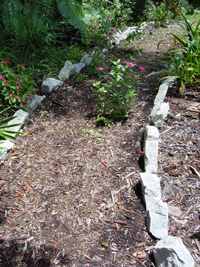 can be very expensive and difficult to come by because, except for
coquina, they must be shipped in from somewhere else. I've found
that a wonderful and usually free substitute is broken concrete.
Soon after I moved here and was well into creating my garden, I
discovered a huge pile of broken concrete at the local theatre where
extensive renovations were being done. While I was getting permission to
take the concrete, I learned that this was part of the original theatre
floor. It was obviously a high grade of concrete because of the
large amount of small gravel imbedded in the concrete making it look
much like granite when broken. All in all I made about 30 trips
with my little dependable truck, and today my "rocks" edge and define
the pathways that meander through my garden. I have since found other
discarded concrete "rocks" that I have used to keep raised beds away
from my patio. You must keep your eyes wide open and alert
while moving about your local streets, because available raw materials
are everywhere if you learn to recognize them. You must also be quick
before they end up in the landfill. Photo note: I didn't have the heart to pull the stray
zinnia in the middle of the path. Like with dogs, you learn to
step around them. can be very expensive and difficult to come by because, except for
coquina, they must be shipped in from somewhere else. I've found
that a wonderful and usually free substitute is broken concrete.
Soon after I moved here and was well into creating my garden, I
discovered a huge pile of broken concrete at the local theatre where
extensive renovations were being done. While I was getting permission to
take the concrete, I learned that this was part of the original theatre
floor. It was obviously a high grade of concrete because of the
large amount of small gravel imbedded in the concrete making it look
much like granite when broken. All in all I made about 30 trips
with my little dependable truck, and today my "rocks" edge and define
the pathways that meander through my garden. I have since found other
discarded concrete "rocks" that I have used to keep raised beds away
from my patio. You must keep your eyes wide open and alert
while moving about your local streets, because available raw materials
are everywhere if you learn to recognize them. You must also be quick
before they end up in the landfill. Photo note: I didn't have the heart to pull the stray
zinnia in the middle of the path. Like with dogs, you learn to
step around them.
|
Another great and usually free material for gardens
is chipped wood (see above photo). I was fortunate to have access to a lot of
chipped wood from the hurricane downed trees a few years ago. The
city offered it free to anyone who wanted to truck it away. I
brought home at least 50 truck loads. That program has ended but
occasionally I'll luck onto some tree guys who have a chipper on their
truck. They're often looking for a place to dump the chipped
limbs, so don't be bashful about asking if you can have it. Your
garden will respond by looking 100% better. You can use it on the paths
or as mulch around the plants. It'll not only visually improve
your garden immediately, but as the wood and leaves break down over time
as decay sets in, they release their nutrients into the earth, becoming
food for your plants.
|
A more elaborate, yet quite utilitarian idea is this novel
method of hiding an ugly, albeit necessary 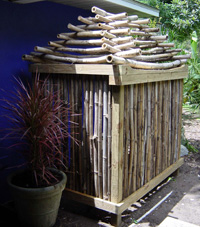 air conditioner, using giant 30 foot bamboo stalks that had been chopped
down to make way for a fence. In this case the bamboo was found
through a local Penny Saver ad because the man cutting the bamboo was
smart enough to know it had value. Bargaining began and the
resulting cost was a mere $20 for the entire pile, resulting in enough
timber to build a bamboo fence and the structure at left, which was
created using the leftover pieces that were anything but straight.
The framework was made using four pressure treated pine 4 x 4s sunk into
the ground and secured with cement. The three side panels were
each made with pressure treated 2 x 4s on the top and bottom and the
bamboo pieces were then nailed onto them creating stability. Each
panel was then attached to the 4 x 4s with screws so they can be easily
removed for maintenance of the unit. The Asian influence was
naturally achieved by taking advantage of the curved pieces of bamboo.
They were stacked and nailed on top of each other two by two until
reaching the top. This is a good example of a very simple idea
resulting in an impressive structure that fits right in with the small
Japanese style garden around the next corner from it. air conditioner, using giant 30 foot bamboo stalks that had been chopped
down to make way for a fence. In this case the bamboo was found
through a local Penny Saver ad because the man cutting the bamboo was
smart enough to know it had value. Bargaining began and the
resulting cost was a mere $20 for the entire pile, resulting in enough
timber to build a bamboo fence and the structure at left, which was
created using the leftover pieces that were anything but straight.
The framework was made using four pressure treated pine 4 x 4s sunk into
the ground and secured with cement. The three side panels were
each made with pressure treated 2 x 4s on the top and bottom and the
bamboo pieces were then nailed onto them creating stability. Each
panel was then attached to the 4 x 4s with screws so they can be easily
removed for maintenance of the unit. The Asian influence was
naturally achieved by taking advantage of the curved pieces of bamboo.
They were stacked and nailed on top of each other two by two until
reaching the top. This is a good example of a very simple idea
resulting in an impressive structure that fits right in with the small
Japanese style garden around the next corner from it.
|
Using the
straightest bamboo canes, this bamboo fence first required a framework of
pressure treated 8 foot 4 x 4s imbedded 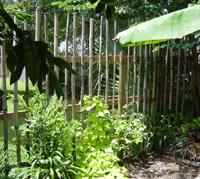 vertically into the ground with concrete about 2 feet deep - and 3
levels of horizontal 2 x 4s. The bamboo canes were then cut
into somewhat uniform lengths, 8 foot in this case, although to add
character the lengths vary within an inch or two and were placed 5 or 6
inches apart. This lends a somewhat more natural look to the fence
and the openness allows the breezes to pass through. If you want
to blot out your neighbors altogether, simply plant climbing vines at
various intervals to encourage a heavy growth to cover the structure.
Alternatively, standard dog eared style fence boards can be added to the
opposite side to achieve that same goal, while leaving the bamboo on
your side for less aggressive vines to climb on. vertically into the ground with concrete about 2 feet deep - and 3
levels of horizontal 2 x 4s. The bamboo canes were then cut
into somewhat uniform lengths, 8 foot in this case, although to add
character the lengths vary within an inch or two and were placed 5 or 6
inches apart. This lends a somewhat more natural look to the fence
and the openness allows the breezes to pass through. If you want
to blot out your neighbors altogether, simply plant climbing vines at
various intervals to encourage a heavy growth to cover the structure.
Alternatively, standard dog eared style fence boards can be added to the
opposite side to achieve that same goal, while leaving the bamboo on
your side for less aggressive vines to climb on.
|
Friends can be
a great source of not only plant material for your garden, but also
non-plant material such as these 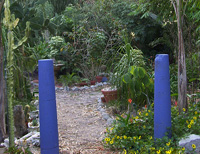 wonderful old solid concrete columns that were salvaged from a house
that had burned down. They once stood proudly on their large bases while
holding up the porch roof of an Atlanta home. They were given to me many
years ago by an Atlanta friend who is also an avid gardener. After standing at the
entrance to my Midtown Atlanta rear garden for many years, there
was no way I could leave them behind, so they moved with me. They now
flank the entrance to my front garden in Florida with a coat of rich
deep Moroccan blue paint. wonderful old solid concrete columns that were salvaged from a house
that had burned down. They once stood proudly on their large bases while
holding up the porch roof of an Atlanta home. They were given to me many
years ago by an Atlanta friend who is also an avid gardener. After standing at the
entrance to my Midtown Atlanta rear garden for many years, there
was no way I could leave them behind, so they moved with me. They now
flank the entrance to my front garden in Florida with a coat of rich
deep Moroccan blue paint.
|
This
pathway material has great sentimental value for me, which is why I
hauled it to Florida with 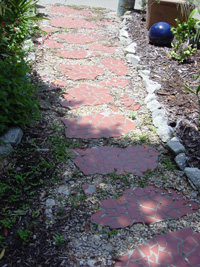 me when I moved here. It was once the front porch floor of my
long time good friend and Atlanta next door neighbor. Mary was a
fellow gardener who died in the prime of her life at age 89. In her
last year, she was no longer able to get into her
garden like she once did, but one day I came home for lunch and there
she was sitting on a turned over bucket
pulling weeds with her nurse standing by in case of trouble. What's that
old saying about old gardeners never die, they just get weeded out?
. me when I moved here. It was once the front porch floor of my
long time good friend and Atlanta next door neighbor. Mary was a
fellow gardener who died in the prime of her life at age 89. In her
last year, she was no longer able to get into her
garden like she once did, but one day I came home for lunch and there
she was sitting on a turned over bucket
pulling weeds with her nurse standing by in case of trouble. What's that
old saying about old gardeners never die, they just get weeded out?
.
After her house sold and was being renovated by the new
owner who pulled up the old porch floor, I asked if I could have the pile of broken terra cotta
tiles that were imbedded in concrete. Later, I gave most of it away, but
I brought this small amount with me to Florida as a remembrance of Mary and all
those years of her friendship. I can still enjoy the stepping stones
because they're in my garden and not in a landfill.
|
There
are several recycled elements in this photo. The pedestal was some
sort of heavy machine housing that I found 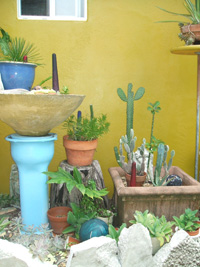 at a rental property that I bought
years ago. I inserted a stepping stone that fit perfectly on top,
painted both blue and voila. I made the large planter sitting on
top. I used a large 24" diameter metal bowl that I bought at a yard sale for
$1. I turned it over, covered it with plastic
and poured thick concrete over the entire thing shaping it by hand.
After it dried I pulled it off, removed the plastic and drilled drainage
holes using a large masonry bit. The tall pedestal on the far right,
partially out of view, is nothing more than a round board I found in the
garage. I painted it, then attached it to a metal threaded end pole and
threaded adapter. It's shoved into the ground and has been there a few
years without leaning. I even used an old tree stump as a short pedestal
at the back. The red and blue glass cylinders were given to me
by a friend and former supplier of art from India. They were
originally long
glass vases made to fit into iron wall holders. I asked her to save
for me anything that broke and this is part of the many things she gave
me. I turned them upside down and pushed them into the potting soil
where you can't see the broken ends. They add an interesting
element to a pot of succulents. I like using pedestals and other things
to give some height to a setting like this against an exterior wall. It
allows me to fit a lot of plants and other interesting objects
into a narrow space. at a rental property that I bought
years ago. I inserted a stepping stone that fit perfectly on top,
painted both blue and voila. I made the large planter sitting on
top. I used a large 24" diameter metal bowl that I bought at a yard sale for
$1. I turned it over, covered it with plastic
and poured thick concrete over the entire thing shaping it by hand.
After it dried I pulled it off, removed the plastic and drilled drainage
holes using a large masonry bit. The tall pedestal on the far right,
partially out of view, is nothing more than a round board I found in the
garage. I painted it, then attached it to a metal threaded end pole and
threaded adapter. It's shoved into the ground and has been there a few
years without leaning. I even used an old tree stump as a short pedestal
at the back. The red and blue glass cylinders were given to me
by a friend and former supplier of art from India. They were
originally long
glass vases made to fit into iron wall holders. I asked her to save
for me anything that broke and this is part of the many things she gave
me. I turned them upside down and pushed them into the potting soil
where you can't see the broken ends. They add an interesting
element to a pot of succulents. I like using pedestals and other things
to give some height to a setting like this against an exterior wall. It
allows me to fit a lot of plants and other interesting objects
into a narrow space.
|
Seating is
very important in a garden. I like to have several strategically
placed seats scattered around my garden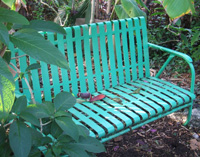 where friends can sit and have a completely different view from each
one. As with most things introduced into my garden, I don't mind when
they are old and used. Often I prefer they be a bit aged. This
makes it easy to select seating that is often free. This wonderful
old vintage iron garden bench came to me through my dentist who is also
a long time good friend. One of his patients told him she
was looking for someone to take it, so he thought of me. A new
coat of paint made it fresh and vital again. It seems over the years
I've become a magnet for useful freebies such as this. where friends can sit and have a completely different view from each
one. As with most things introduced into my garden, I don't mind when
they are old and used. Often I prefer they be a bit aged. This
makes it easy to select seating that is often free. This wonderful
old vintage iron garden bench came to me through my dentist who is also
a long time good friend. One of his patients told him she
was looking for someone to take it, so he thought of me. A new
coat of paint made it fresh and vital again. It seems over the years
I've become a magnet for useful freebies such as this.
|
This
interesting structure was built using limbs from trees that I removed
shortly after purchasing my current home.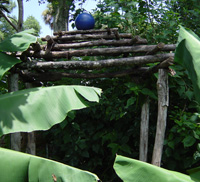 There were too many trees struggling for the same small amount of space.
Instead of sending them to the landfill, I decided to recycle them by
creating this simple structure. The finial on top is a blue
bowling ball found at a local thrift store. The largest pieces
were treated with a water seal suitable for wood and then painted with
tar before sinking them into the earth. An occasional coating of
sealer will make this structure last for a few years. Paint is
also an option to give it a new look in the future . It no longer
stands, having been a victim of one of our hurricanes, but it lasted
about 3 years. The remnants are now scattered around the garden where
they continue to decay adding nutrients to the earth. There were too many trees struggling for the same small amount of space.
Instead of sending them to the landfill, I decided to recycle them by
creating this simple structure. The finial on top is a blue
bowling ball found at a local thrift store. The largest pieces
were treated with a water seal suitable for wood and then painted with
tar before sinking them into the earth. An occasional coating of
sealer will make this structure last for a few years. Paint is
also an option to give it a new look in the future . It no longer
stands, having been a victim of one of our hurricanes, but it lasted
about 3 years. The remnants are now scattered around the garden where
they continue to decay adding nutrients to the earth. |
|
|

